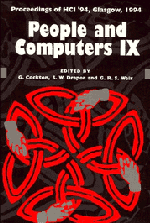Book contents
- Frontmatter
- Contents
- Preface: HCI'94 – You Probably Haven't Seen It All Before
- Part I Invited Papers
- Part II Methodology of Interactive Systems Development
- Crafting Interaction: Styles, Metaphors, Modalities and Agents
- 10 A Comparison of Placement Strategies for Effective Visual Design
- 11 Evaluation of Alternative Operations for Browsing Hypertext
- 12 On the Problem of Selecting Interaction Objects
- 13 Minimising Conceptual Baggage: Making Choices about Metaphor
- 14 Keeping an Eye on your Interface: The Potential for Eye-Based Control of Graphical User Interfaces (GUI's)
- 15 A Linguistic Approach to Sign Language Synthesis
- 16 Generalisation and the Adaptive Interface
- 17 Agent-Based Interaction
- Modelling Humans, Computers and their Interaction
- Notations and Tools for Design
- Part VI Computer-Supported Cooperative Work
- Author Index
- Keyword Index
10 - A Comparison of Placement Strategies for Effective Visual Design
Published online by Cambridge University Press: 04 August 2010
- Frontmatter
- Contents
- Preface: HCI'94 – You Probably Haven't Seen It All Before
- Part I Invited Papers
- Part II Methodology of Interactive Systems Development
- Crafting Interaction: Styles, Metaphors, Modalities and Agents
- 10 A Comparison of Placement Strategies for Effective Visual Design
- 11 Evaluation of Alternative Operations for Browsing Hypertext
- 12 On the Problem of Selecting Interaction Objects
- 13 Minimising Conceptual Baggage: Making Choices about Metaphor
- 14 Keeping an Eye on your Interface: The Potential for Eye-Based Control of Graphical User Interfaces (GUI's)
- 15 A Linguistic Approach to Sign Language Synthesis
- 16 Generalisation and the Adaptive Interface
- 17 Agent-Based Interaction
- Modelling Humans, Computers and their Interaction
- Notations and Tools for Design
- Part VI Computer-Supported Cooperative Work
- Author Index
- Keyword Index
Summary
The development of graphical user interfaces for interactive applications is subject to a series of well-known problems which could be relevant of the domain of visual design. This typically includes the problem of placing aesthetically interaction objects (IO) according to principles applied in placement strategies. This paper first reviews the problem of IO placement and shows the rationale for the most significant placement strategies found today. It then tries to compare six such strategies along several dimensions and mathematical relationships with respect to three points of view: the designer's point of view, the human factors expert's point of view, and the user's point of view.
Keywords: arrangement, dimensioning, interaction object, localization, interaction object placement, placement strategy, visual design.
Introduction
The problem of placement concerns the spatial position of interaction objects (IO) such as edit box, radio button, list box, … with respect to visual elements in a screen layout. Effective placement can be achieved through a particular placement strategy involving a certain amount of visual techniques such as proximity, alignment, separate reference, centering, and conformity. For instance, Galitz suggests a placement strategy where IOs should be placed according to their nature:
“All elements on a screen should be located in a unique and consistent position. These elements are: title, screen identifier, screen body (including caption, data, section headings, completion aids, prompting), status or instructional messages, error messages, command field or area.” (Galitz, 1992)
In this paper, the placement is defined as the description of a composite IO (e.g. a form container widget) for displaying IOs to be placed relatively to one another. Composite IOs generally allow IOs to resize themselves as the composite resizes.
- Type
- Chapter
- Information
- People and Computers , pp. 125 - 144Publisher: Cambridge University PressPrint publication year: 1994
- 4
- Cited by



